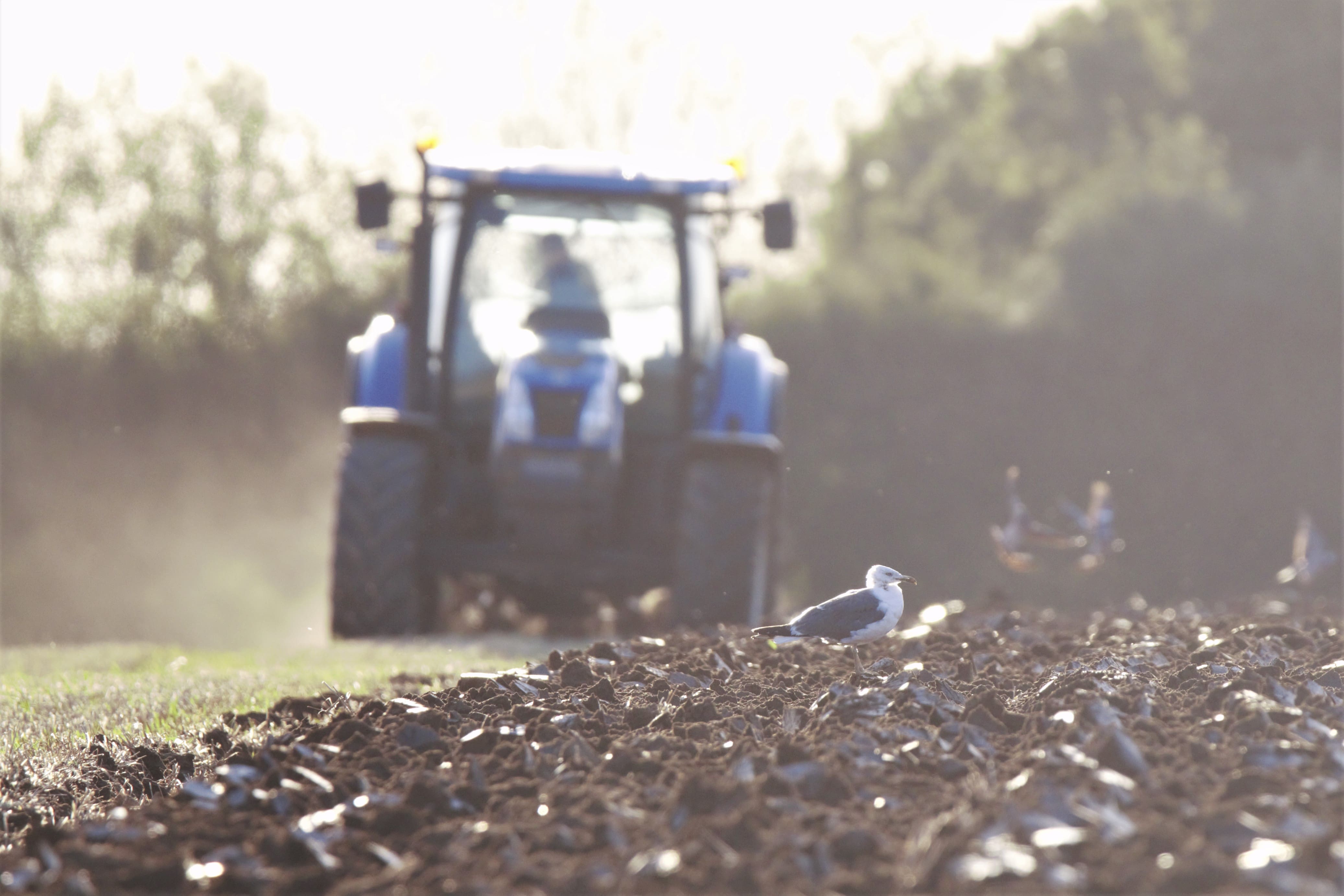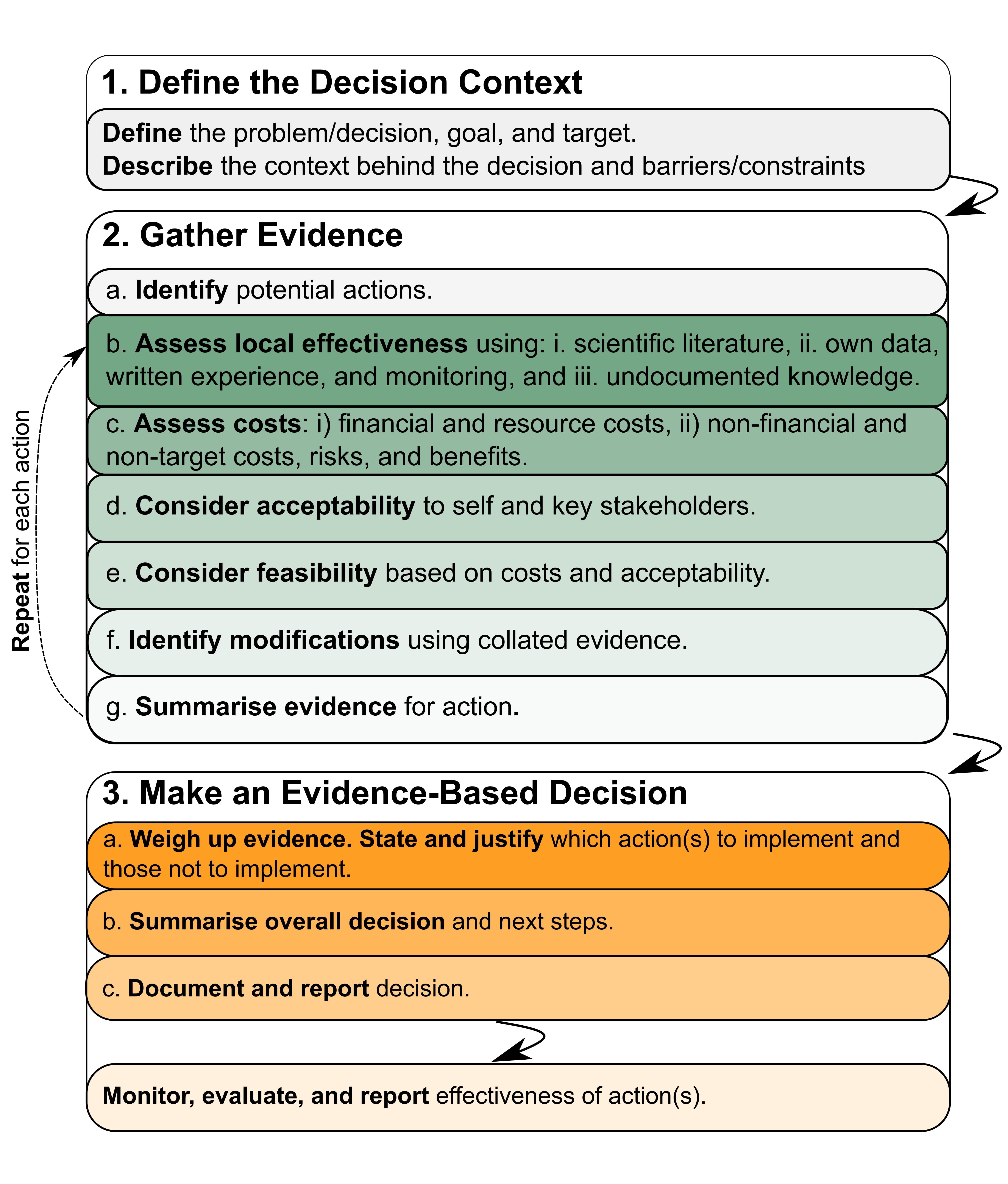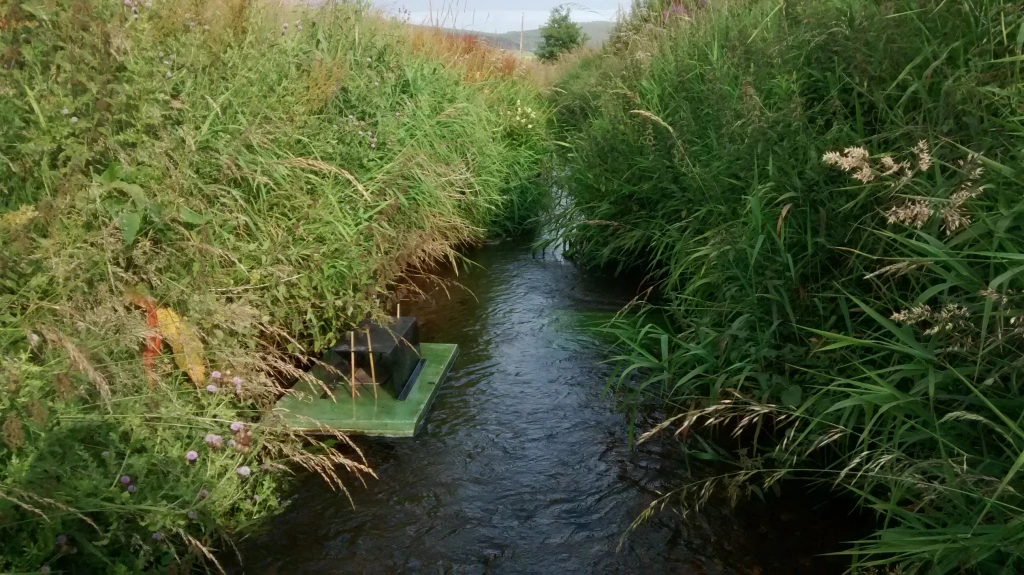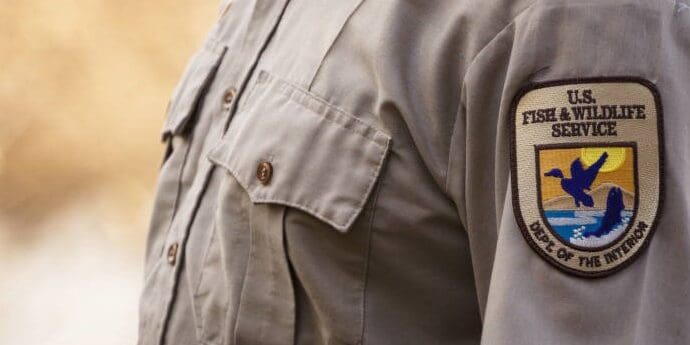Helping practitioners to make and document conservation decisions: the Evidence-to-Decision tool
Alec Christie is a research fellow at Downing College, Cambridge and recently completed his PhD in evidence-based conservation with the Conservation Evidence group.
This post has been adapted from an article previously published in Conservation Land Management


When undertaking actions to restore habitats or conserve wildlife, we often have to make difficult decisions. Which actions are best to benefit bird species or pollinators? How effective will these actions be? Are they feasible to implement, and acceptable to other stakeholders? To make decisions, conservationists have to use and combine various sources of information – including evidence on the effectiveness of different strategies, costs, feasibility and acceptability – and ensure that limited funds are used to maximum effect. The process is time-consuming, and often ends up being duplicated when knowledge of why past decisions were made is lost, for example because of turnover in staff. Here I outline a new decision support tool developed jointly between conservation researchers and practitioners that helps to document the evidence and thinking behind decisions.
Why is using evidence important?
When explaining the benefits of using evidence, I try to get people to use a broad definition of what evidence is – in this case, ‘any relevant information to assess a claim about a question of interest’ (adapted from Salafsky et al. 2019). This means that local knowledge, scientific papers, organisational reports, historical and archival material, as well as your own data and notebooks all count as evidence. The process of using evidence is a way of learning from our collective past failures and successes, so that we do more of what works and less of what does not. By avoiding ineffective, suboptimal, or harmful actions, there is potential to save time, money and resources. In addition, by using evidence drawn from a wide range of sources and ensuring that local knowledge is incorporated, we can better foster engagement in, and ultimately support for, management actions, which are then more likely to succeed. So how does the tool we’ve developed help to achieve this?


The Evidence-to-Decision tool
Adapted from a medical decision-making framework that came out in 2016, the Evidence-to-Decision tool was co-designed and tested by practitioners from a range of conservation organisations in the UK and abroad in 2020 and 2021. The tool lays out a step-by-step process by which to assess which actions (if any) should be taken to achieve a particular goal, by drawing on different pieces of evidence.
One of the key advantages of the tool is that it helps to provide a record of how and why decisions were made. Short-term contracts and frequent staff turnover are common in the conservation, ecology, and land management sectors, and so the aim of this documentation process is to ensure that future staff can understand why past actions were taken. They can then update and reassess these decisions based on new evidence and thinking in the future. I like to think of this as an ‘evidence audit’ – it helps to ensure that decision-makers are doing their due diligence and provides some transparency and accountability over decision-making.
More fundamentally, the tool offers a step-by-step template for how organisations could embed evidence-based decision-making into their practices. The tool helps to assess the successes and failures of past projects (alongside external evidence from other sources) to decide what to do next. These next steps could be to implement different actions, take no action, conduct further research or use a more in-depth decision-making process. This process encourages a cycle of adaptive management, with decisions and actions repeatedly evaluated and reassessed to improve practice on the ground.
How does the tool work?
There are three steps to the process. The first is to ‘Define the Decision Context’, which involves recording relevant background information on the decision being made, such as the target and intended outcome of any management action, the constraints on decision-making (budgets and legislation, for example), and relevant stakeholders. For example, this could involve describing a problem such as how to reduce the mortality of amphibians crossing roads. Important information to document here would include the available budget for any potential actions, stakeholders (e.g., the local council and residents who own and use the road), and Natterjack toads as a target species.


The second step, ‘Gather Evidence’, has several sections to ensure that diverse sources of evidence can be used to assess whether to implement each action. First you are prompted to identify potential actions that could help in achieving the desired goal (e.g., ‘Install tunnels under roads’ or ‘Use toad patrols on roads’). Once these potential actions have been stated, you are then guided through the process of assessing the available evidence on different aspects of each option (e.g., How effective are tunnels at reducing mortality? Are toad patrols cost-effective? Is tunnel construction feasible based on the equipment and resources available, and is it acceptable to stakeholders?). At different stages, you are asked to rate the effectiveness, costs, acceptability, and feasibility for each action, as well as uncertainty, based on the evidence available.
The final step is to ‘Make an Evidence-based Decision’. The tool helps you weigh up the evidence to determine which actions (if any) should be implemented, including a summary comparison table that presents scores from the previous section for each action (on effectiveness, costs, acceptability, and feasibility, as well as uncertainty). For example, this section will get you to think about whether the best option is to install tunnels under roads and/or use toad patrols, or to do nothing and instead do some trials, consultations, and/or research before acting.
Throughout all three steps, the tool prompts users to record their evidence and reasoning in separate text fields. The online tool allows you to download a summary report that sets out this evidence-based decision-making process, while the offline Microsoft Word template can be filled out as a report to do the same. This means that the information can be saved for future reference to aid further decision-making or help reassess past decisions. Users are also encouraged to monitor, evaluate, and report on the results of implemented actions – regardless of success or failure – for the benefit of others faced with similar decisions. Potential venues to publish these findings include Applied Ecology Resources (www.britishecologicalsociety.org/applied-ecology-resources) and the Conservation Evidence Journal (www.conservationevidencejournal.com) – amongst many others!
Examples of the tool in action
The Evidence-to-Decision tool is still being tested and refined, but the prototype is being utilised by several conservation organisations to help with efforts to integrate evidence into their decision-making processes. Practitioners have used the tool to address a variety of management dilemmas, including how to improve habitat for dormice in woodland, effective mink control to conserve water voles, how to reduce microplastic pollution in rivers, invasive plant species control in ancient woodland, how to improve the breeding success of little terns and the best ways to change tillage practices to benefit soil biodiversity.


As an example of the process, imagine you are a warden working on the issue of reducing the mortality of amphibians crossing roads on your nature reserve. After defining the problem, you would then identify different potential actions to tackle this issue. Using Conservation Evidence (www.conservationevidence.com), for example, you might decide to assess the following actions: 1. Install culverts or tunnels as road crossings; 2. Install barrier fencing along roads; and 3. Use humans to assist amphibians across roads. You would then gather evidence to assess whether to implement each action. For action 1, for instance, you might note that the scientific literature suggests culverts or tunnels have mixed effects on amphibians and could even be harmful, and this concurs with your local knowledge and experience. Some estimates of financial costs also suggest this action would exceed your intended budget, whilst the potential to cause harm makes this action too unacceptable. By repeating this for the other actions, and weighing up the evidence gathered, you can then justify which actions you believe should be implemented or not. In this case, you may decide that the evidence suggests that action 1 should not be implemented, but implementing actions 2 and 3 can be justified based on evidence on factors such as effectiveness, costs, and acceptability.
What decisions should the tool be used for?
Time is always a problem in decision-making. To work out how much time is appropriate to invest in considering the evidence using a decision tool such as this, we would recommend using the Strategic Evidence Planning Framework developed jointly by a group of researchers and practitioners (Sutherland et al. 2021). For regular, day-to-day decisions with lower importance and lower risks, it would be inefficient and unfeasible to invest time in following a rigorous structured decision-making process. When decisions of higher risk and importance are considered, however, time should be devoted to thoroughly assessing the available evidence, which is where a step-by-step process such as the Evidence-to-Decision tool can help.
A lower-risk decision might involve, for example, selecting which types of owl nest boxes to place on farmland; the cost here is likely to be low and the risks posed by failing to attract owls are low. A higher-risk decision could involve deciding how to enhance grassland to benefit owl populations by changing land management practices across an entire estate; any intervention here could be expensive and risky if unsuccessful. This higher-risk decision would therefore benefit from more in-depth and rigorous scrutiny of evidence gathered from a wide range of sources, whilst the lower-risk decision could be made much more rapidly based on readily available evidence. Essentially, think about how much certainty you need to be able to act (i.e., weigh up the risks and costs of getting the decision wrong), and then invest an appropriate amount of time in gathering and assessing evidence to make an informed decision.
The Evidence-to-Decision tool is designed to be flexible, so that users could spend anywhere between an hour to several days using it to guide their decision-making. The quantity of evidence that is collated and assessed, and the amount of time spent considering and weighing up that evidence, can be adjusted as required based on the importance and risk associated with the decision. It’s also worth stating that if little evidence can be found to fill out the different sections of the tool, then users can simply state this and move on – however, this lack of evidence should then be accounted for when making the decision.
The point of the tool is to make it clear what evidence and reasoning has been used. In addition, it is also perfectly reasonable that your decision could be to take no action because there is too much uncertainty or risk – in this case, reporting on the next steps to gather more evidence (possibly including conducting research) is important so that the decision can be revisited in future using the tool.
Accessing the tool and getting involved
The Evidence-to-Decision tool is available online at www.evidence2decisiontool.com, where you can also find an offline template that can be used and adapted to suit your needs. There is also a user guide that provides additional advice and lists useful resources, whilst Christie et al. (2021) provide further detailed information on the tool.
Organisations and individuals in conservation are very welcome to get involved with the testing and usage of the Evidence-to-Decision tool. If you are interested in a free workshop session covering how to use the tool and some more information about the Conservation Evidence project, please get in touch at info@conservationevidence.com or with me directly through apc58@cam.ac.uk.
Acknowledgements
This blog post is an adjusted version of an article published in the Conservation Land Management magazine in winter 2021/22. I would like to thank the following people and organisations (in no particular order) who tested and provided feedback on the Evidence-to-Decision tool: Michael Winter from the University of Exeter; David O’Brien from NatureScot; Matthew Grainger from the Norwegian Institute for Nature Research; Paul Tinsley-Marshall, Steve Weeks, Alison Ruyter and Rory Harding from the Kent Wildlife Trust; Thomas White, Harriet Downey and William Sutherland from the University of Cambridge; Tom McPherson from Ingleby Farms; Karen Hornigold at the Woodland Trust; Conservation Evidence; Winifred Frick and Jon Flanders at Bat Conservation International; Kathy Wormald at Froglife; the Medway Valley Countryside Partnership; Bedfordshire, Buckinghamshire and Oxfordshire Wildlife Trust; Catherine McNicol at Gloucestershire Wildlife Trust; the 2019 cohort of Master’s in Conservation Leadership students, University of Cambridge.
References and further reading
Christie, A. P., Downey, H., Frick, W. F., Grainger, M., O’Brien, D., Tinsley-Marshall, P., Winter, M., White, T. B., & Sutherland, W. J. 2021. A practical conservation tool to combine diverse types of evidence for transparent evidence-based decision-making. Conservation Science and Practice In Press.
Downey, H. 2020. Evidence-based decision making in conservation and land management: why it is important and how it can be done. Conservation Land Management 18(2): 14–19.
Wordley, C. 2016. What works in conservation? Conservation Land Management 14(1): 14–17.
Salafsky, N., Boshoven, J., Burivalova, Z., Dubois, N.S., Gomez, A., Johnson, A., Lee, A., Margoluis, R., Morrison, J., Muir, M., Pratt, S.C., Pullin, A.S., Salzer, D., Stewart, A., Sutherland, W.J., Wordley, C.F.R., 2019. Defining and using evidence in conservation practice. Conservation Science and Practice 1: e27. https://doi.org/10.1111/csp2.27
Sutherland, W. J., Downey, H., Frick, W. F., Tinsley-Marshall, P., & McPherson, T. 2021. Planning practical evidence-based decision making within time constraints: the Strategic Evidence Assessment Framework. Journal for Nature Conservation 60: 125975.




[…] posted and adapted from the Conservation Evidence blog and Conservation Land […]